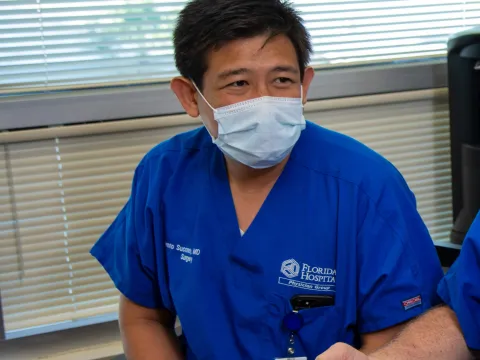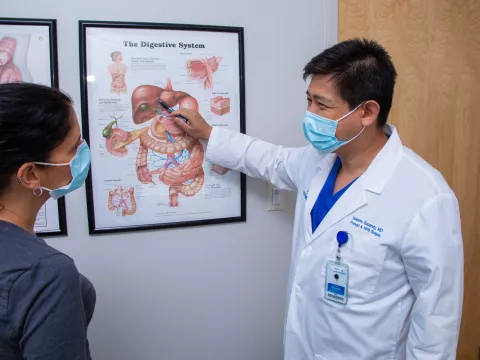- AdventHealth Digestive Health Institute
Choose the health content that’s right for you, and get it delivered right in your inbox.
Imagine that you are a surgeon and have been practicing for a few years. You realize that many operations today have become easier for patients and surgeons alike. However, some procedures have advanced beyond what you learned during your training. How do you increase your knowledge so you can offer your patients better care?
To educate other surgeons about the latest advances in their field, the surgeons at AdventHealth Digestive Institute Tampa (DI) routinely present at professional conferences and other continuing medical education (CME) events.
Recently, Iswanto Sucandy, MD, FACS, advanced HPB (liver, pancreas and bile duct) surgeon, shared two DI video presentations as part of a live educational webinar put on by the American College of Surgeons (ACS). The ACS is the largest professional group for surgeons in the world. It has more than 82,000 surgeon members from all different surgical subspecialties. DI’s other advanced HPB surgeons, Alexander Rosemurgy, MD, FACS, and Sharona Ross, MD, FACS, are also fellows of the society and regularly present at similar events.
According to the ACS website, part of the mission of the Video-Based Education program is “to educate surgeons and members of surgical teams in order to improve the care of the surgical patient.” On March 16, Dr. Sucandy did just that by sharing two video presentations with a live virtual audience of 120 people. By explaining footage from two operations, Dr. Sucandy showed them how he uses the surgical robot to remove cancer in the liver and bile ducts.
“My presentation panel went overtime due to interest from multiple institutions,” Dr. Sucandy says. He notes that the international group of surgeons asked him a lot of questions so they might eventually use robotic surgery – a minimally invasive approach – for their patients.
Robotic Surgery for Liver Cancer in Tampa
Dr. Sucandy’s first video presentation – “Robotic Resection of Right Posterior Superior Metastatic Lesions” – was about using the surgical robot to remove two cancer tumors in the liver.
Sitting under the right lung, the liver is a complex organ that performs about 500 different functions. It’s so important that it’s the only part of the body that can regenerate itself when a portion is removed.
Unfortunately, the liver is a common place for other cancers to metastasize, or spread. When colon cancer moves outside the colon, it often spreads to the liver. These tumors are still colon cancer tumors, but removing them requires a surgeon with expertise in liver surgery.
Although many surgeons use minimally invasive techniques that avoid an open procedure for many operations, such is not the case for liver surgery. Even today, only about 1 in 10 liver operations is done as a minimally invasive procedure.
In hopes that more HPB surgeons will start using robotic surgery for the liver, Dr. Sucandy explained the steps to take to remove two metastatic cancer tumors from three sections on the right side of the liver.
Robotic Surgery for Bile Duct Cancer (Cholangiocarcinoma)
Bile duct cancer, also known as cholangiocarcinoma, is a rare cancer. Many complex surgical oncologists do not operate on bile duct cancer. Even rarer is it to find surgeons such as Dr. Sucandy, Dr. Rosemurgy and Dr. Ross who offer minimally invasive bile duct surgery. Because the advanced HPB surgeons at DI avoid using large, open operations, they seek to give their patients with Klatskin tumor a robotic procedure.
A Klatskin tumor is a cancer that forms where the right bile duct meets the left bile duct inside the liver. In his video presentation, “Robotic Klatskin Tumor Type 3b Resection,” Dr. Sucandy explained how he, Dr. Rosemurgy and Dr. Ross use the surgical robot to delicately remove the membranes and tissues to reach the tumor.
The robot translates the surgeons’ fine movements in tight spots within the body. This is particularly important for bile duct cancer. There are major blood vessels in the liver near the surgical site. Surgeons need to identify these vessels and secure them so they stay intact.
Once the surgeons carefully remove the Klatskin tumor and nearby lymph nodes, these tissues are sent away to be looked at under a microscope. While the patient is still under general anesthesia, doctors called pathologists look at the tissues. If the pathologists see that the edges, or “margins,” of the removed tissue contain cancer or one or more lymph nodes do, the surgeons may have to do more surgery to get the entire tumor out.
In this particular case, the DI surgeons removed all of the cancer the first time around. The surgical robot – with the magnified 3-D, high resolution view it gives surgeons – is often better than an open surgery would be in helping them do that. Because a minimally invasive operation could be done, the patient was able to leave the hospital three days after surgery.
The easier recovery, with less pain, that robotic surgery offers can help patients with cancer move onto their next stage of treatment sooner. Dr. Sucandy, Dr. Rosemurgy and Dr. Ross at DI remain committed to sharing their expertise with other surgeons so more patients can ultimately reap the benefits of a minimally invasive operation.
If you or a loved one has a digestive cancer, find out if robotic surgery may be right for you. To schedule a surgical consultation, call us at Call844-650-5950.





